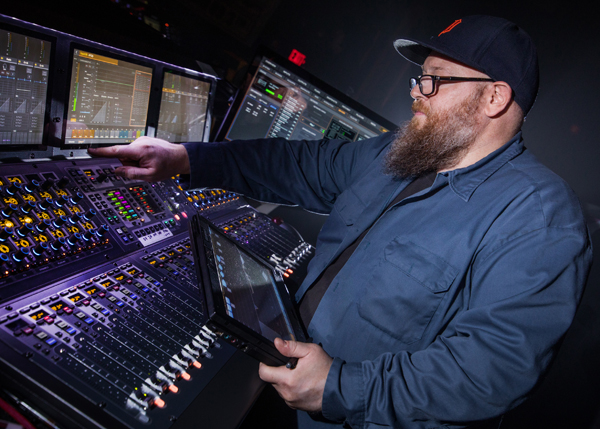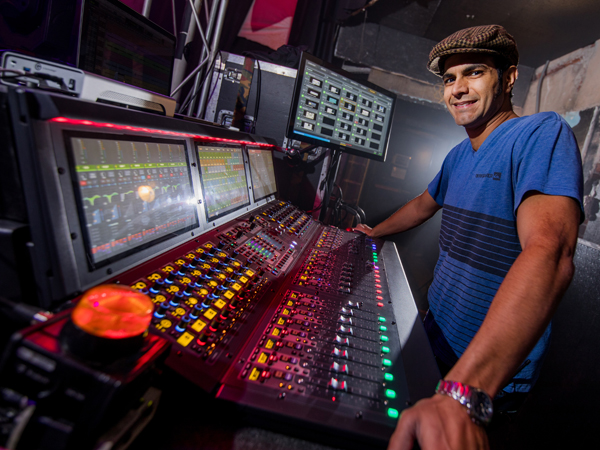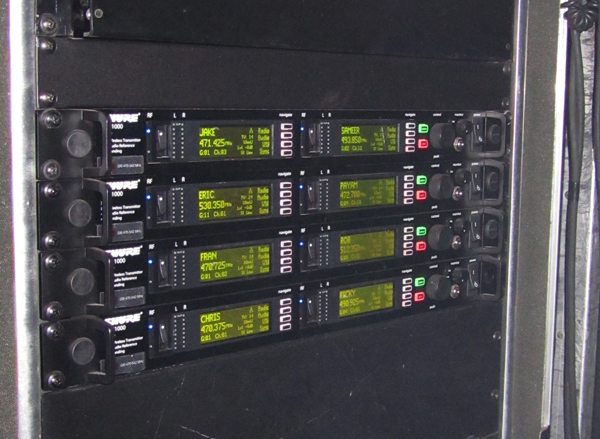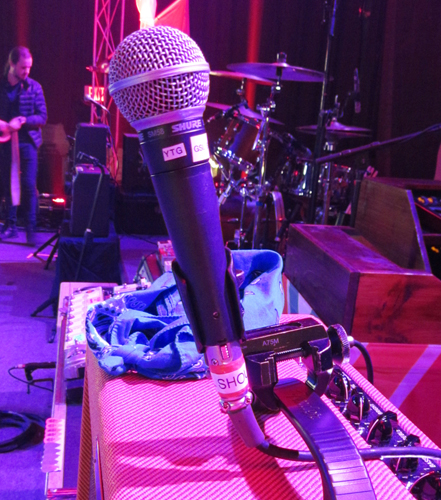Alternative/indie rock band Young The Giant’s ongoing ‘Home of the Strange’ tour of North America has already visited high-profile venues like the Greek Theater in Los Angeles, Radio City Music Hall in Manhattan, Austin City Limits, and numerous others.
Valentine’s Day 2017 saw the LA-based five-member group visiting at the 900-capacity Bourbon Theater in Lincoln, NE, serving as an interesting opportunity to observe how the band’s veteran sound team adapt to an unfamiliar system and acoustics.
It’s a bus tour carrying consoles, microphones, in-ear monitors and assorted other pieces supplied by Clair Global (Lititz, PA) while relying on ‘racks and stacks’ and power distro provided by each venue/promoter. At the Bourbon Theater, the house system proved to be Grund Audio mains (four UB-2020 full-range loudspeakers per side) with eight GT-LPB-36CX dual 18-inch subwoofers on the deck, with audio power from QSC PLX and RMX Series amplifiers.
Load-in for that show commenced at 11 am for a 4 pm sound check, with front of house engineer Harley Zinker and monitor engineer Ricky Leon implementing the Avid VENUE | S6L digital mixing systems they’re both carrying along with getting the stage equipped while backline techs set up the instruments and a MIDI rig.

“Since I don’t know the room and haven’t heard the system, I’ll shoot some pink noise using (Rational Acoustics) Smaart software to analyze what’s going on,” Zinker notes. “Then I’ll play some familiar songs and walk the room. I’m listening for how the highs and lows translate, and if I know that a particular song has a booming sub, I’ll listen to how that’s going to play in the room and do my adjustments from there.”
He’s also traveling with a pair of Lab Gruppen LM44 digital processors (running the Dolby Lake software on a wireless tablet), deployed for system EQ and delay. “Once we’re all ready, Ricky and I do a line check with the backline techs to make sure everything’s working and sounds right before the band takes the stage.”
Starting Points
The S6L mix systems, recently released by Avid, deliver an updated version of the VENUE software found in the Profile systems both engineers previously in addition to a more customizable layout, greater input capacity and processing power, and full Pro Tools integration. Specifically, each engineer is equipped with a S6L-24D surface, E6L-192 engine and a Stage 64 I/O rack.
Depending on the specifics of a given show and venue, usually 55 sources feed the FOH and monitor mix systems via a Clair passive analog splitter. Mics for vocals and instruments are largely from Shure, an assortment of dynamics and condensers as well as KSM313 ribbon designs on a couple of guitar amps. While the band has talked about going to wireless mics, all remain wired at this point. Direct feeds are facilitated by Radial boxes, including J48 DIs and SW8 auto switcher DIs for keyboard and playback.

Managing and mixing these sources on his S6L, Zinker explains, “I have two starting points – an indoor starting point for a club or a theater and an outdoor starting point for a festival or amphitheater. They’re based on good shows that I’ve had in the past couple of months. I set up the S6L file structure to establish a good ‘base line’ so that when I EQ, I’m not making changes on channel strips. We’re using the same backline and the same mics, and I want to do minimal changes to the channels.”
These starting-point files also include snapshots and other relevant information. “I update my show files whenever anything changes with an instrument or amplifier, or when we get a new guitar, so I don’t need to punch things in again,” he adds.
His experience with the Profile platform proved instructive in the switch to the S6L. “If you can mix on a Profile, you can mix on the S6L,” he states. “I use song-specific ‘snapshots’ (scenes) for mutes, dynamics and plugins, but not the faders. We’re not a time-code show.”
In setting up his 24-fader mix surface in layers, VCA faders are in the center bank, and then he switches the left and right banks to access vocals and instruments as needed. A fourth ‘utility layer’ is utilized for song-specific effects returns, iPod type inputs and pink noise.
Although lead vocalist Sameer Gadhia controls his own effects station, Zinker adds a touch of effects when the singer’s on a ‘dry’ mic. “I apply a delay, which I have snapshotted song by song, and also a doubler plugin to fatten up his voice a little bit. There’s also an Avid reverb for his vocal, along with overdrive that adds a great texture.” Other song-specific effects include a delay on hi-hat and a mic preamp distortion emulator on specific mics.
The Other Audience
Monitor engineer Ricky Leon’s audience is the band, which is on Ultimate Ears UE18, UE11 and UE-RM earpieces fed by Shure PSM 1000 personal wireless systems that are also supplemented by Rev33 passive impedance correction devices. On larger stages, the tech crew may also supplement with side fill monitors and/or a drum sub borrowed from the venue.

With all inputs wired, the IEMs are the only wireless aspect of a Young The Giant show, which Leon notes makes RF management a lot easier. “We’re on the G10 band,” he says, “and it’s a frequency range that tends to be very favorable across the U.S. I haven’t had any issues, even in larger cities.”
He runs the wireless packs at standard gain with mixes hot off the desk, which translates to high metering on the transmitters: “It’s all about getting a good mix to the transmitters which translates to a good signal to the receiver packs,” he says.
Via his S6L, Leon provides eight stereo in-ear mixes; five to the band members, two for on-stage techs and one for himself. The mixes are similar, including select recorded tracks, a mono slate, and a click track, but each band member hears their own singing/playing more directly, and he does some additional tailoring.

For example, he applies light, 3:1 compression via the S6L on Gadhia’s vocal, with Bomb Factory LA2A emulation for limiting and a SansAmp plugin for some “crunchy attitude” on a couple of songs. “And for the song ‘Amerika,’ I add a three to four second tail to the reverb in Eric’s monitors (guitarist Eric Cannata) because he wants this massive, swimming tail, while a multi-band compressor gets rid of string noise,” he adds.
A Busy Place
S6L snapshots help Leon quickly adjust levels, effects, and mutes on a per-song basis, and he utilizes the mixer’s layers to bring mics and other sources to the left, center and right fader banks quickly. He’s also responsible for managing the band’s recorded tracks, which include percussive sounds, certain background vocals, and low-end synth sounds.
Further, each performance is recorded to a Pro Tools rig, and before the band arrives for the late-afternoon sound check, Leon plays back the previous show’s recording to help set up his mixes via the console’s ‘virtual sound check’ functionality.
A unique aspect he’s established via his S6L is a ‘shout system’ that allows the band members and tech team to verbally communicate during setup and shows. Some players are provided with dedicated mics in this scenario, while others, such as drummer Francois Comtois, have a foot-switch tied into their vocal mics to key into the shout system. It feeds everyone’s IEMs, while at FOH, Zinker has set up a fifth layer on his S6L to access the feed, which is routed to a small powered loudspeaker on his console.

Chatter on system during setup may be about anything from technical questions to lunch break, while during the show, Leon feeds it to the techs but not to the musicians. However, their shout mics continue to work so they can alert the techs of any issues.
It all adds up to a consistent, highly functional performance environment for Young The Giant as they move from venue to venue. “The band wants a CD-quality mix,” Leon states. “So I’m always doing everything possible to make the show the best I can for them.”














